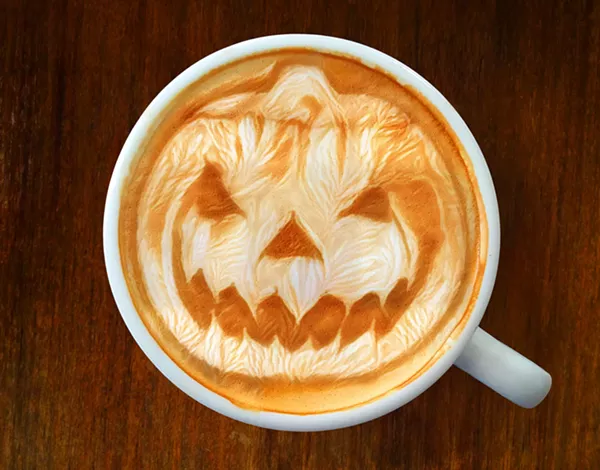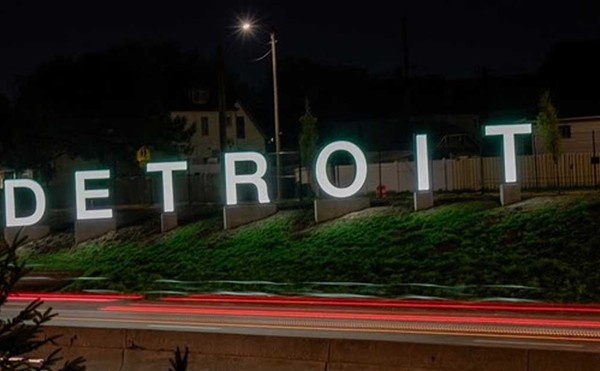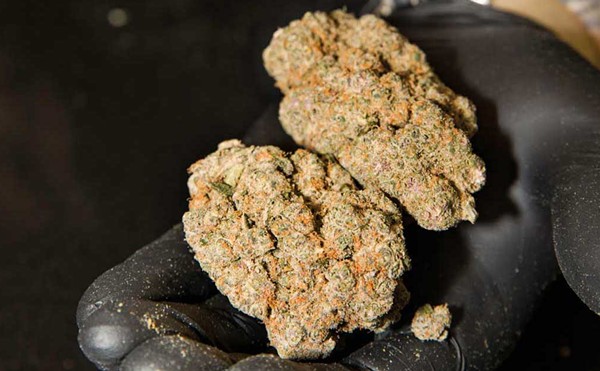We're weeks into fall, which can only mean one thing: a preponderance of all things pumpkin spice.
Of course, there's the ubiquitous Starbucks Pumpkin Spice Latte, or the #PSL as it is affectionately known on Instagram. There's pumpkin spice doughnuts, pumpkin spice cookies, and pumpkin spice beer. You can have pumpkin spice Cheerios for breakfast, and pumpkin spice Oreos for dessert.
Even Detroit area vendors are getting in on the action — from corporate chains like Olga's Kitchen (which is serving up Pumpkin Spice Bread Pudding this fall) to mom and pop shops like Bon Bon Bon (which has a line of seasonal pumpkin chocolates) and Trinosophes (where you can currently order housemade pumpkin butter with biscuits). A local vegan pop-up, the Grim Feeder, even recently hosted an all-vegan pumpkin spice-themed brunch at Ferndale's Urbanrest Brewing Co., with a menu that included pumpkin spiced chili, pumpkin pie oatmeal, and pumpkin spiced waffles.
However, it seems that in recent years the marketplace has produced some truly bizarre pumpkin spice offerings, too — including, but not limited to, pumpkin spice deodorant, dog treats, Burnett's vodka, and fettuccine pasta. As The Detroit News' Melody Baetens notes in a recent column, CVS sells pumpkin spice cough drops. Trader Joe's even sells Pumpkin Spiced Pumpkin Seeds, which may very well be the ouroboros eating its own tail.
Clearly, the pumpkin spice business is booming. According to data from Nielsen reported by the New York Times, sales of pumpkin-flavored items reached $414 million in the U.S. between July 2016 and July 2017 — an increase from $286 million from the same period of time in 2013.
Of course, it's worth noting that "pumpkin spice" isn't really a thing. As the New York Times points out in an explainer video, many so-called "pumpkin spice products" contain no actual pumpkin, as the gourd is relatively flavorless, especially compared to the formulas of processed food. What we are referring to when we say "pumpkin spice" is really a combination of cinnamon, clove, nutmeg, and ginger. Sometimes this is made from oils made from real spices. Sometimes it's made from their synthetic equivalents. What really drives the demand for the products is their status as what the industry calls an LTO — a limited-time offering.
In a recent op-ed for the New York Times, Frank Bruni calls pumpkin spice mania a "zombie apocalypse, if the zombies wore nutmeg cologne," before recognizing the chilling truth — "Pumpkin spice is America."
"It's invention run amok, marketing gone mad, the odoriferous emblem of commercialism without compunction or bounds," Bruni writes. "It's the transformation of an illusion — there isn't any spice called pumpkin, nor any pumpkin this spicy — into a reality."
He even goes a bit further: "Oh, hell, let's just go there: It's Donald Trump," he writes. "I don't mean the color of his hair, though pumpkin spice is as good a description of it as any. I mean that pumpkin spice became special by shamelessly insisting that it was and ruthlessly creeping into every corner of the culture that was docile, dippy, or lazy enough to accommodate it."
Yikes. How did we get here?
Pumpkins weren't always regarded this way. As Time magazine points out in a recent history of the trend, early American settlers considered pumpkins to be useless — a food fit only for peasants, with "pumpkin-eater" slung as a derogatory term. However, attitudes changed during the Industrial Revolution, when city dwellers' nostalgia for rural life found an embodiment in the pumpkin. Eventually, pumpkins became a treat.
Interestingly, the pumpkin's classist connotations have come full-circle in its corporate 21st century pumpkin spice flavor incarnation. In a recent, hilarious essay ("I used every pumpkin spice product I could find for a week. Now my armpits smell like nutmeg.") Washington Post reporter Maura Judkis tried every pumpkin spice product she could find — more than 40 products in total. She noted how the pumpkin spice latte has become the de facto symbol of the maligned "basic bitch" — women with conventional, pedestrian tastes.
As Judkis writes "the 'Basic Bitch' ... revels in conventional pursuits like Nicholas Sparks novels, wearing leggings, and brunch. The term originated in hip-hop and was co-opted by white women, and somewhere in that process, pumpkin spice became the ultimate symbol of basicness — sweet, bland, unoriginal. To call someone basic is classist, because typically, it's the wealthy who can afford to cultivate less conventional tastes. But the insult has been reclaimed by its victims: There are essays about how women are 'proud to be basic,' and, in turn, proud to love pumpkin spice."
However, as Judkis reports, we could be seeing the end of the trend: While pumpkin spice products increased by 20 percent in 2013 over the previous year, this year saw only 6 percent growth. And a recent 1010data study spots what looks like pumpkin spice's supply and demand problem: in an analysis of online purchases of pumpkin spice-flavored products from August 2016 to December 2016, the study found that while the number of pumpkin spice products available had increased by nearly 50 percent from the previous year, sales increased only 21 percent.
"Sales are not keeping pace," Samir Bhavnani, 1010data vice president of consumer insights, told Eater. "The conclusion that I draw from the data is that pumpkin spice has jumped the shark."
However, it might just be a matter of #PSLs turning into #MPLs: This autumn, Starbucks debuted its latest limited edition concoction: the Maple Pecan Latte.
The horror.







